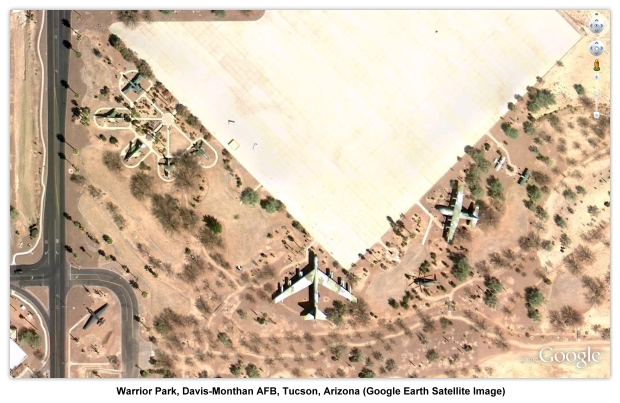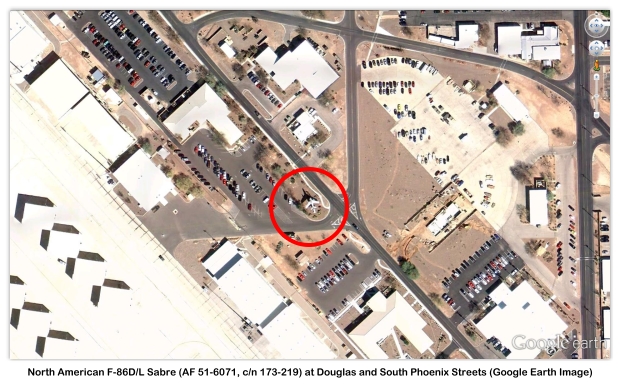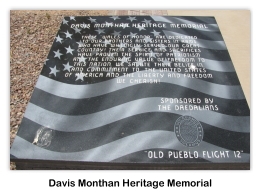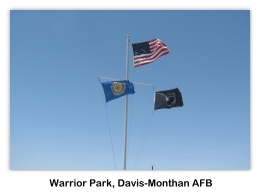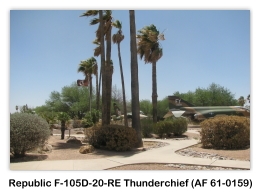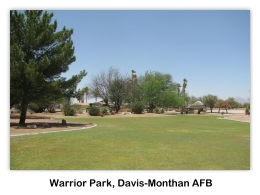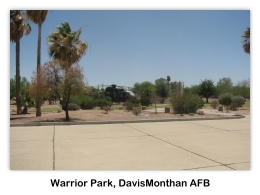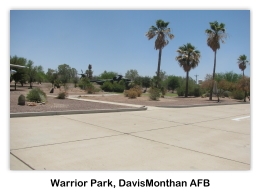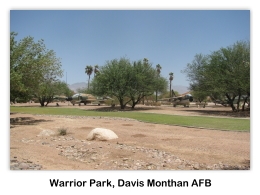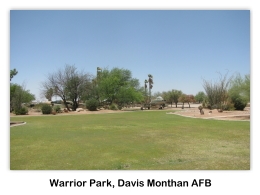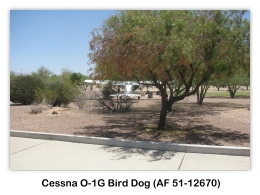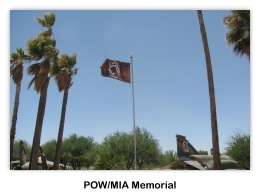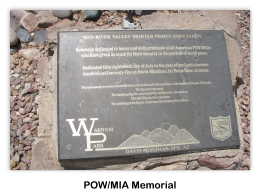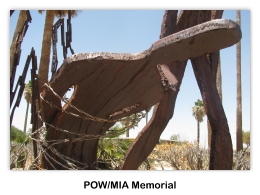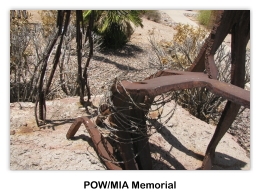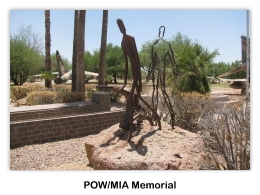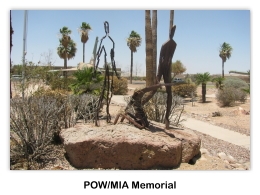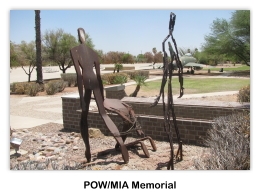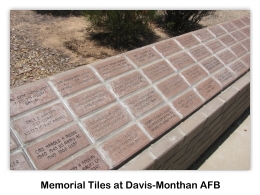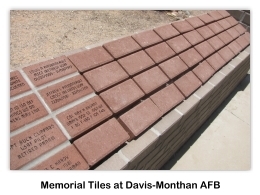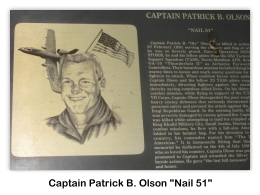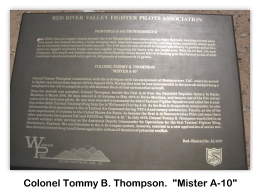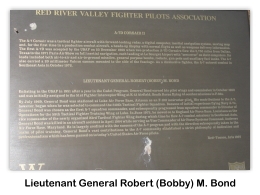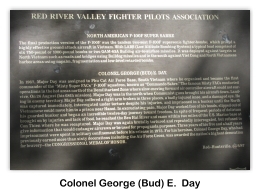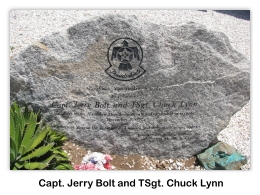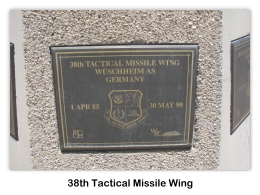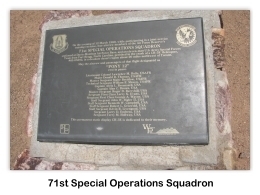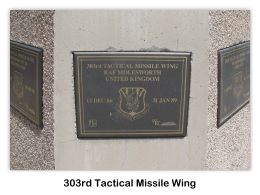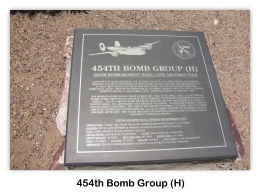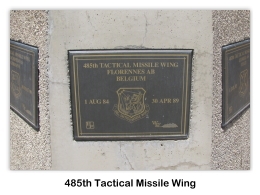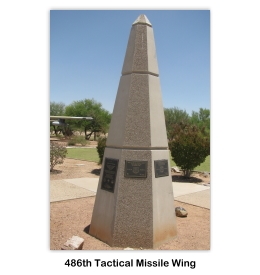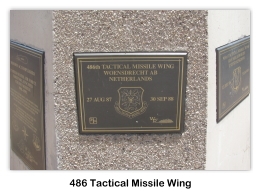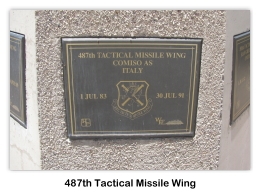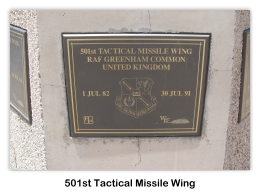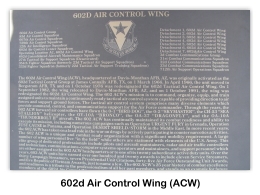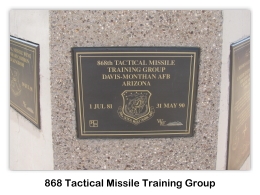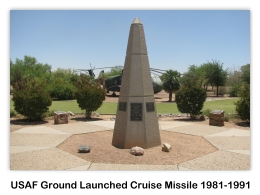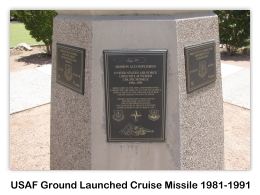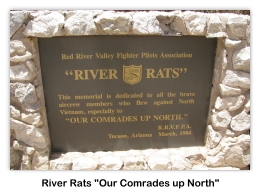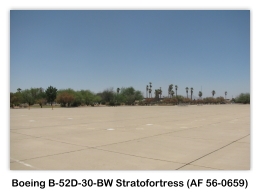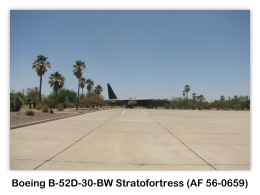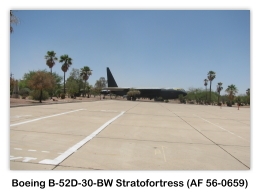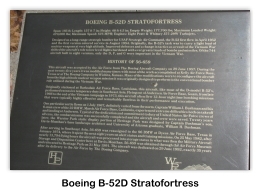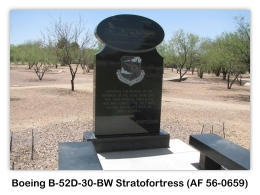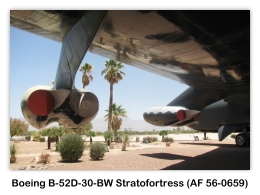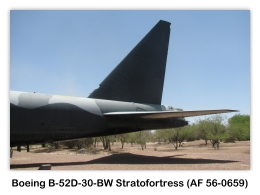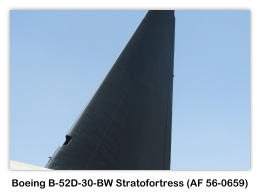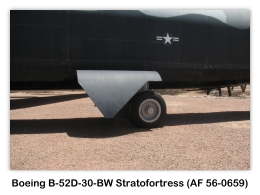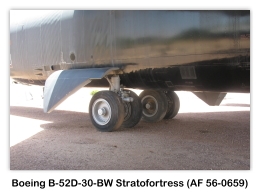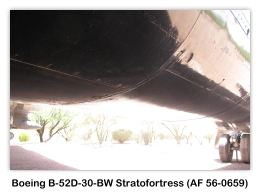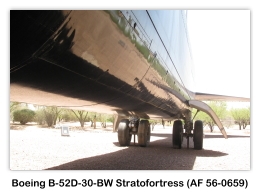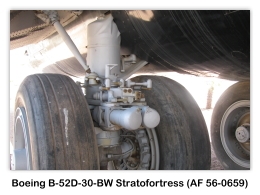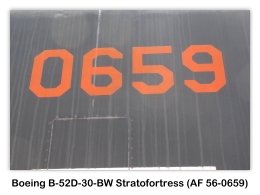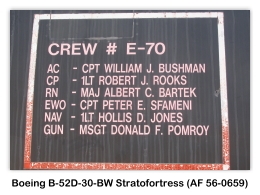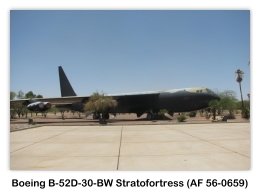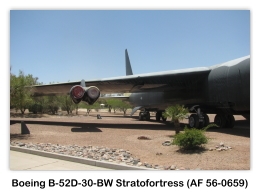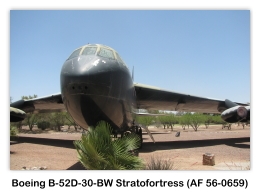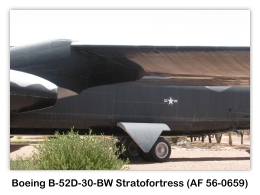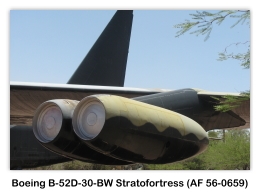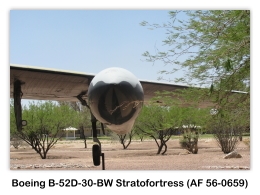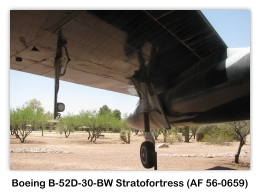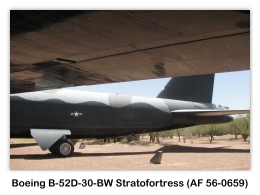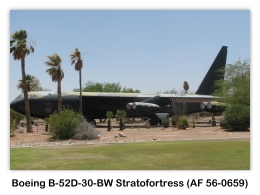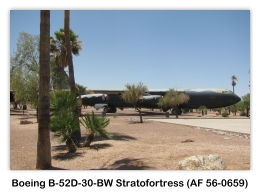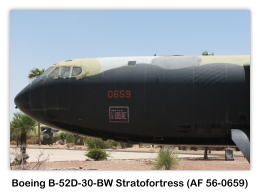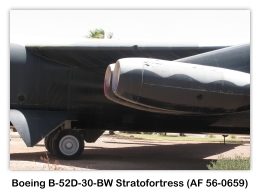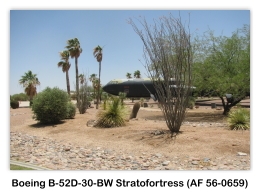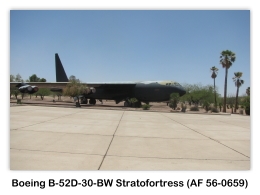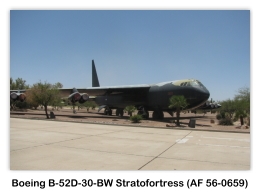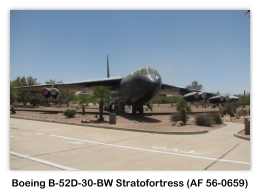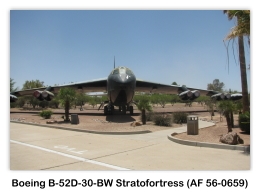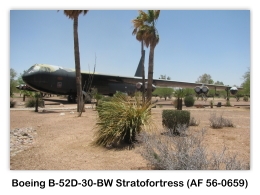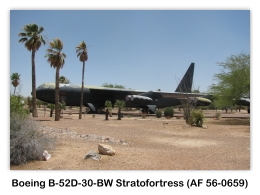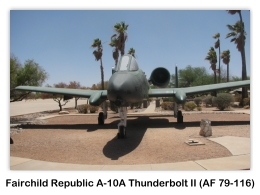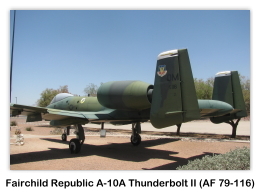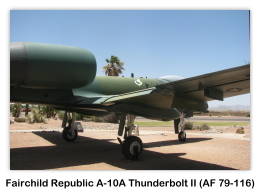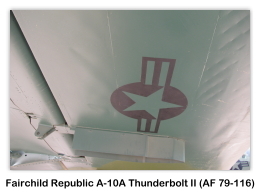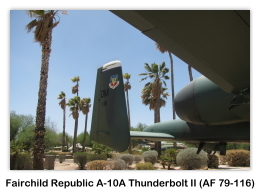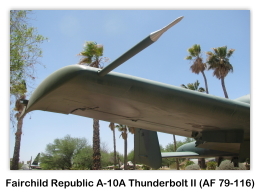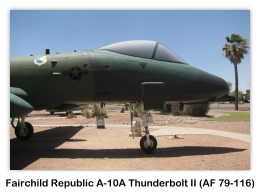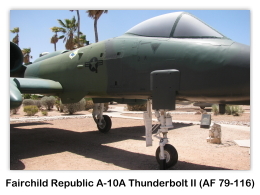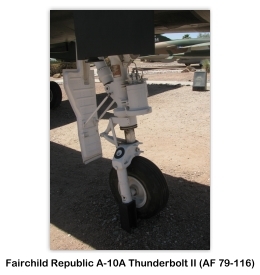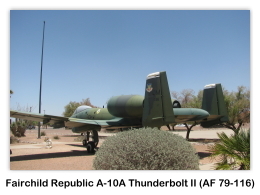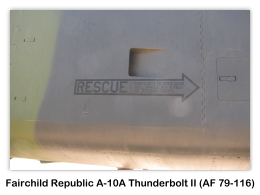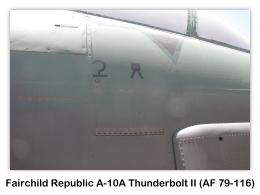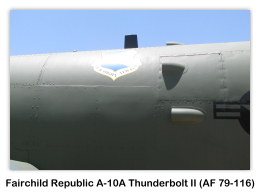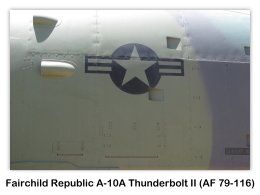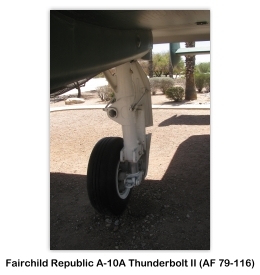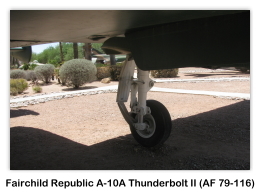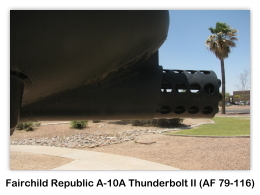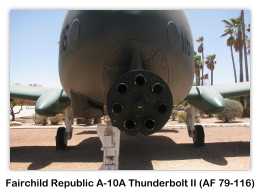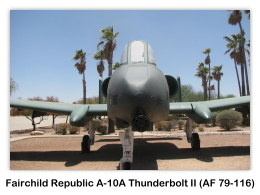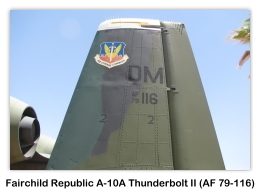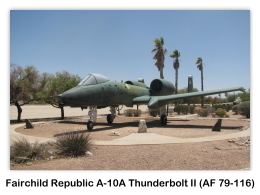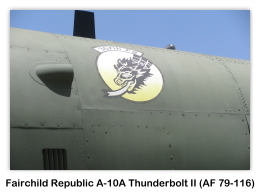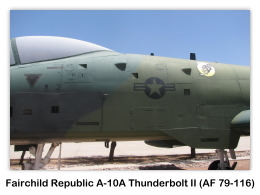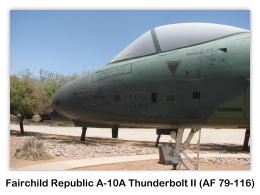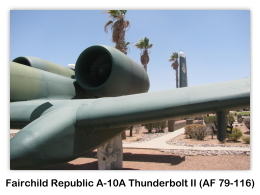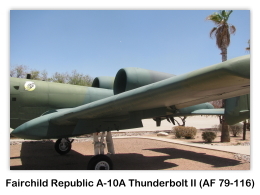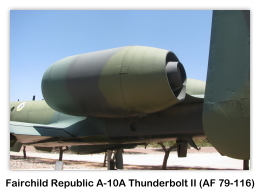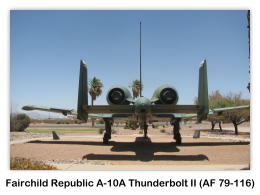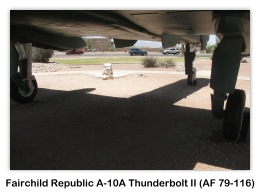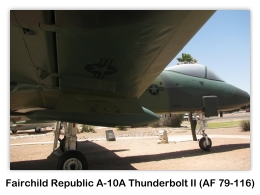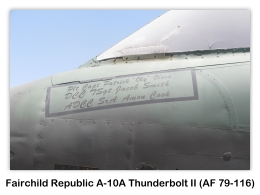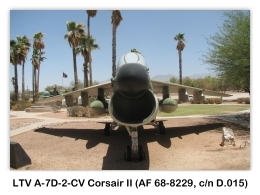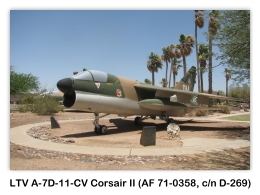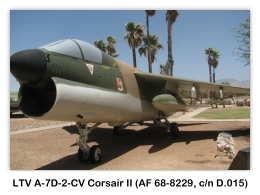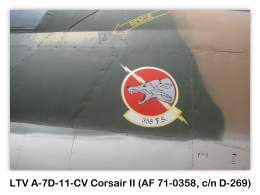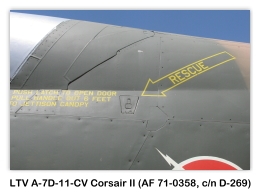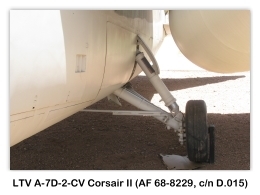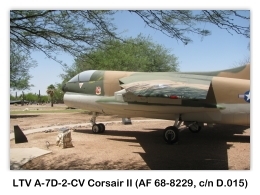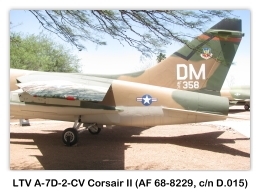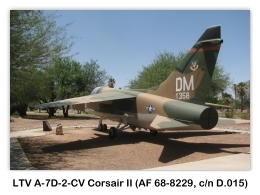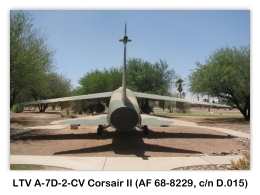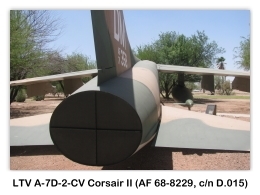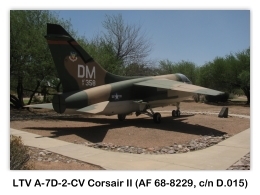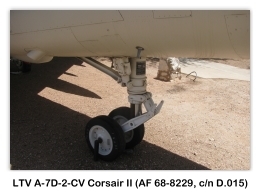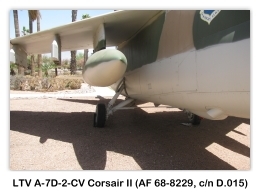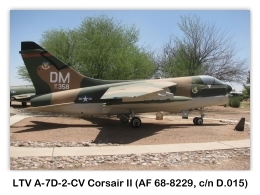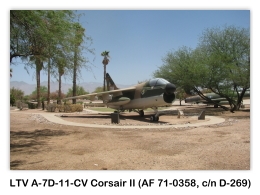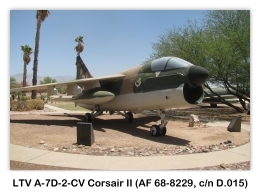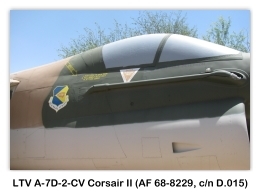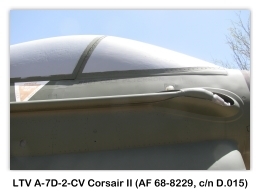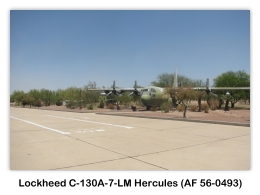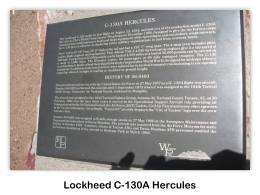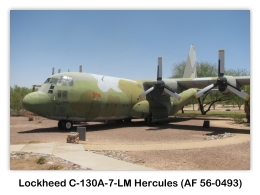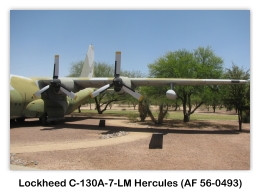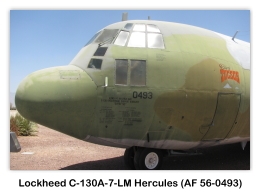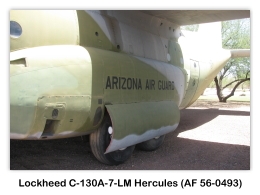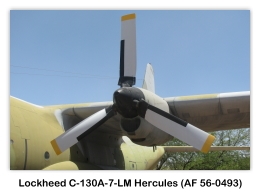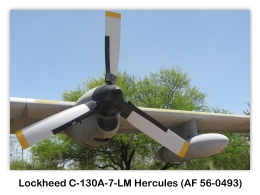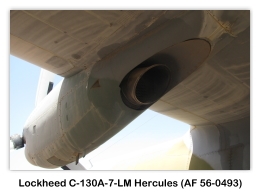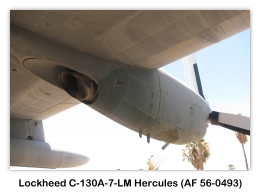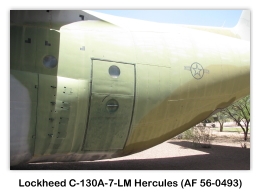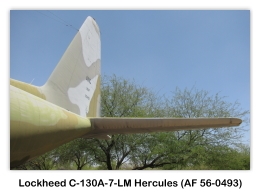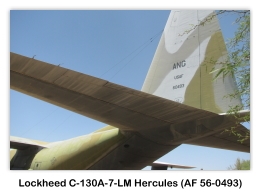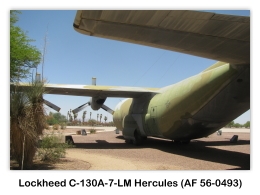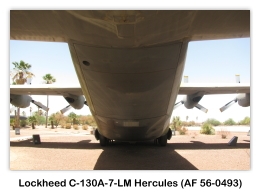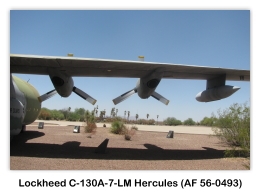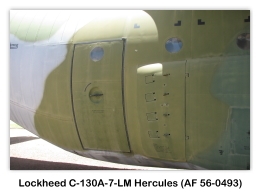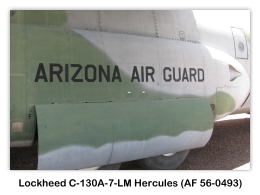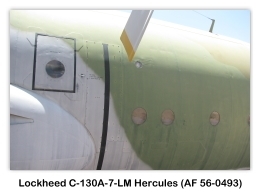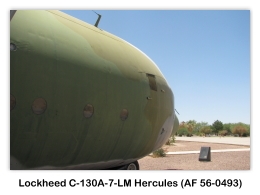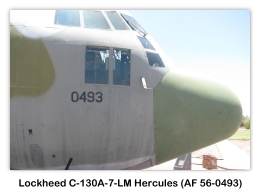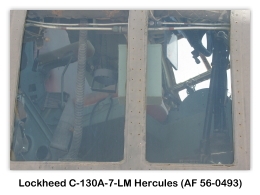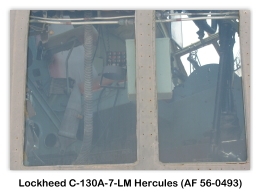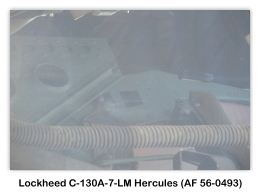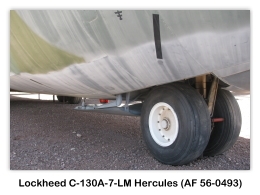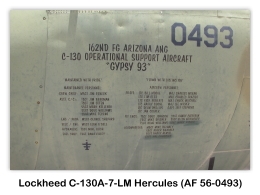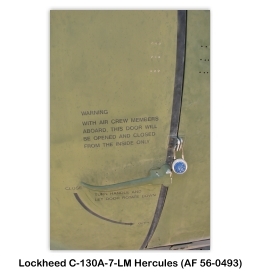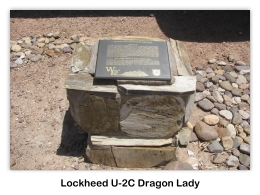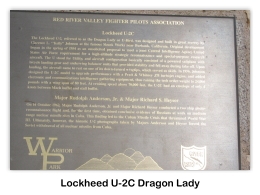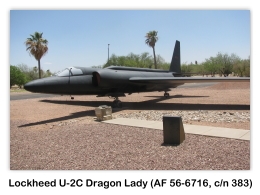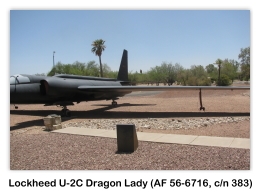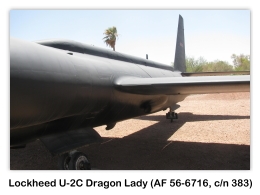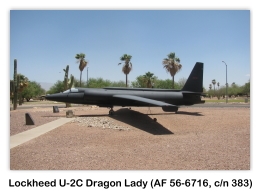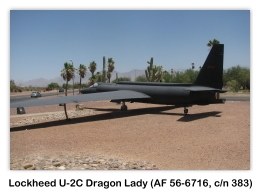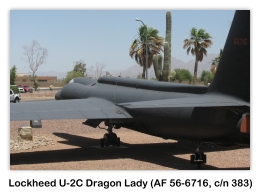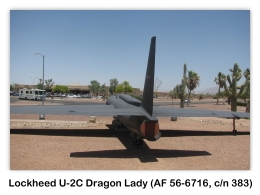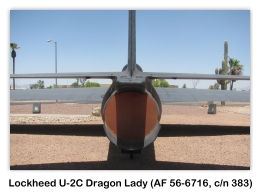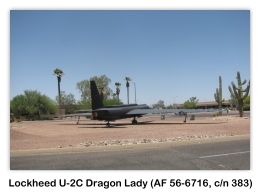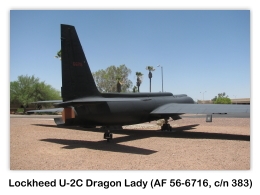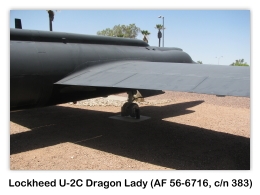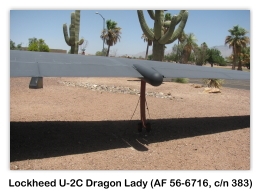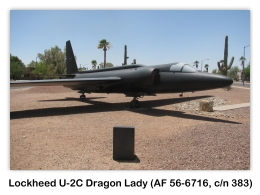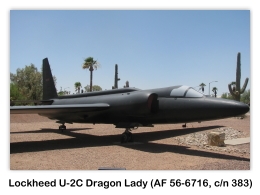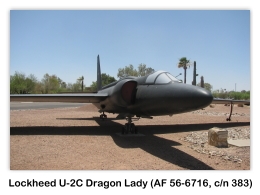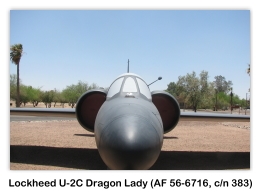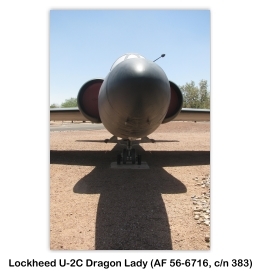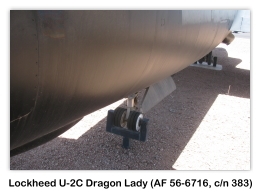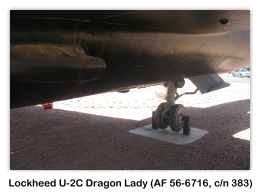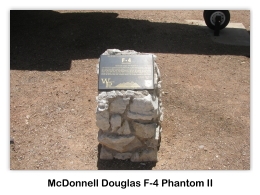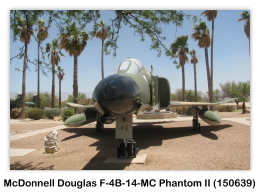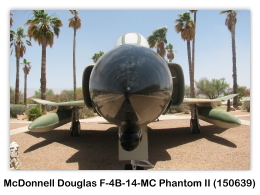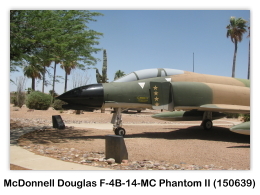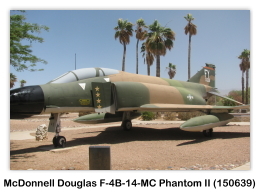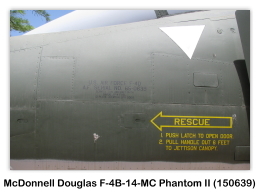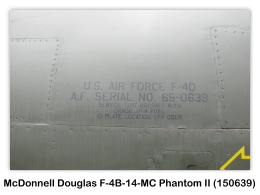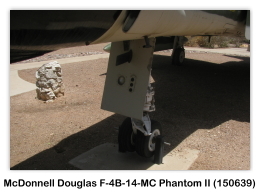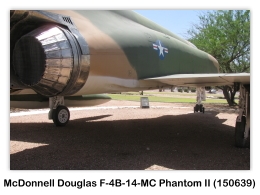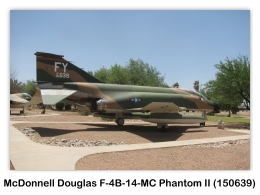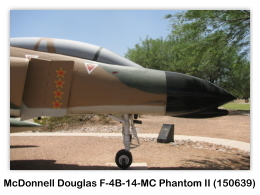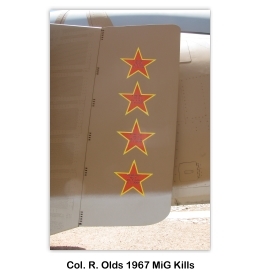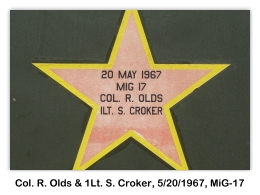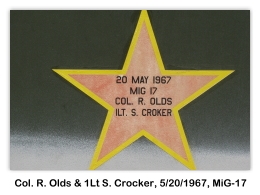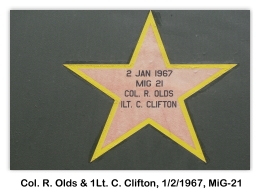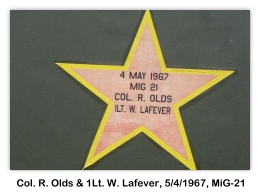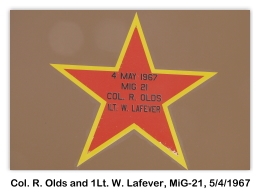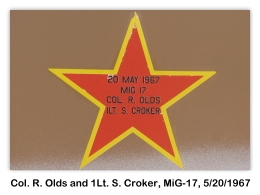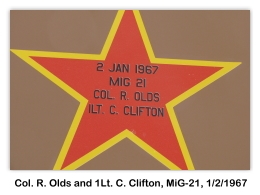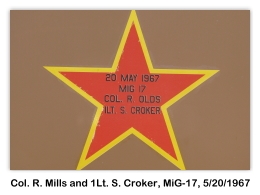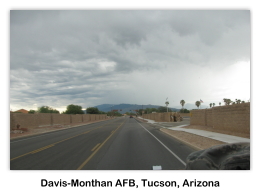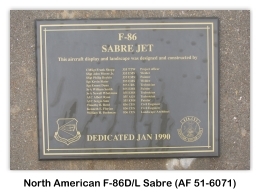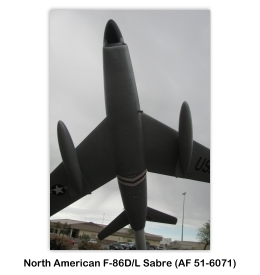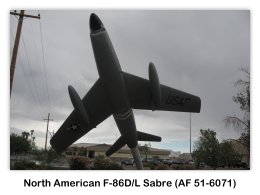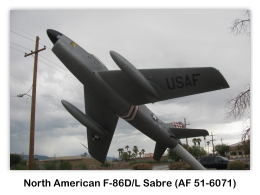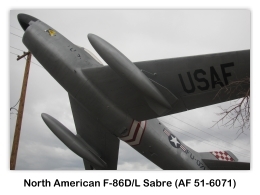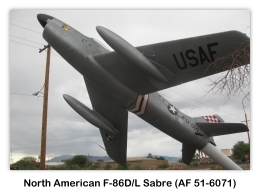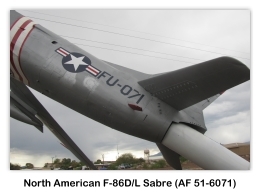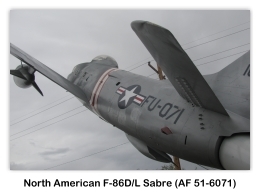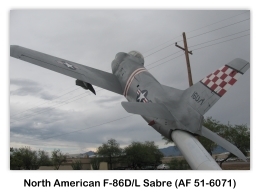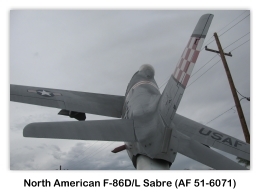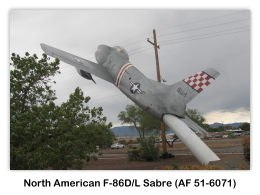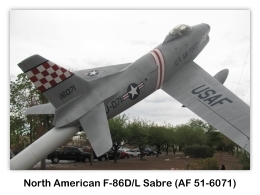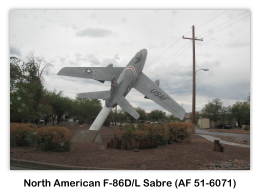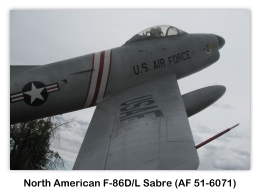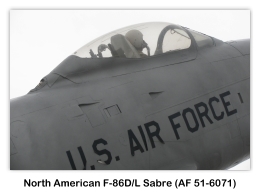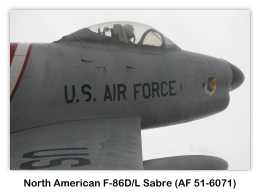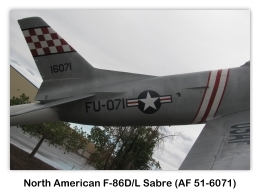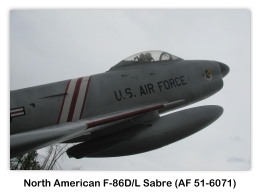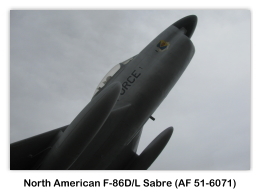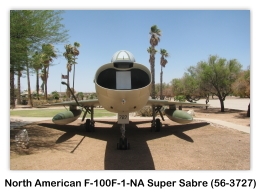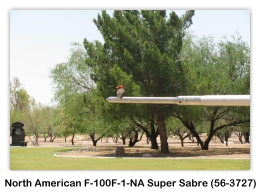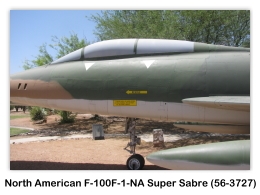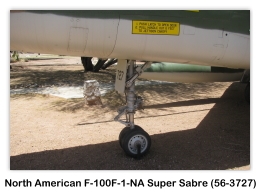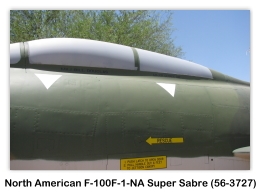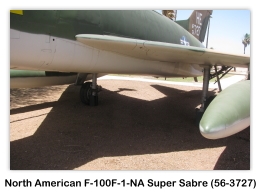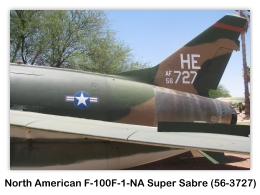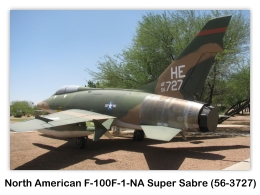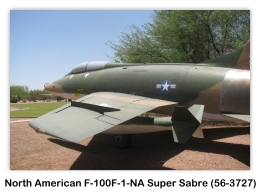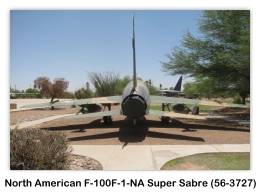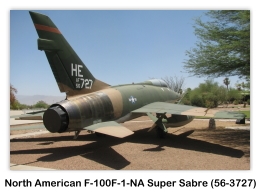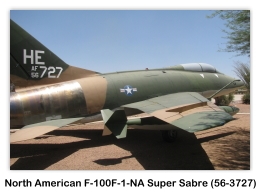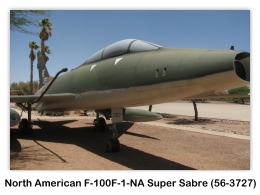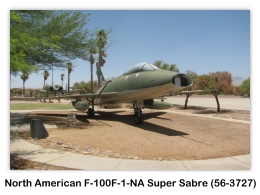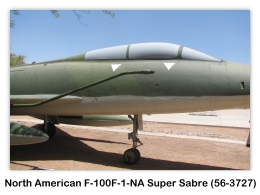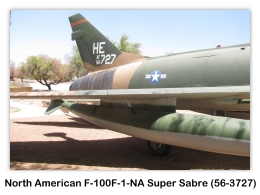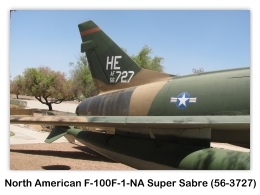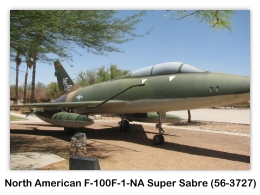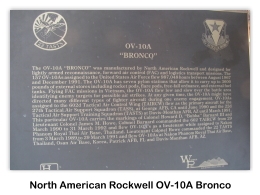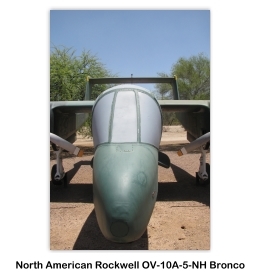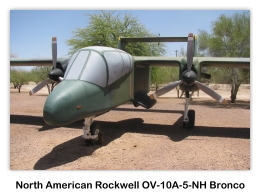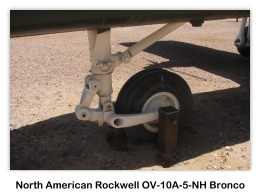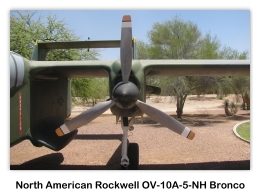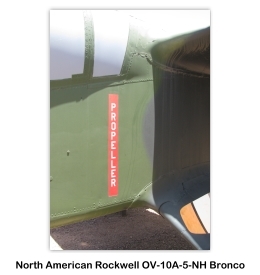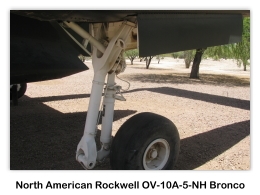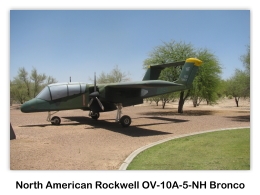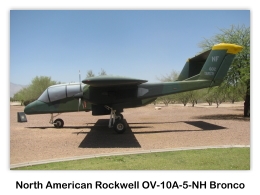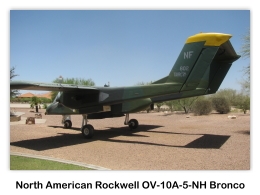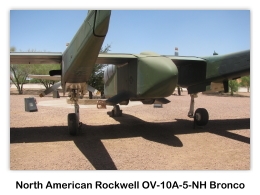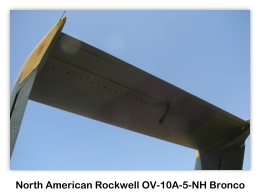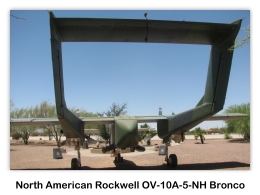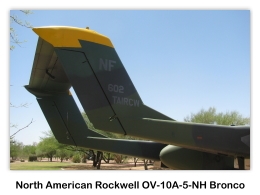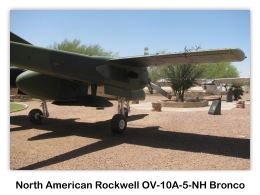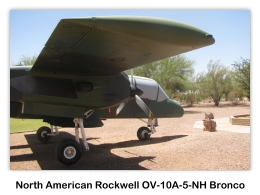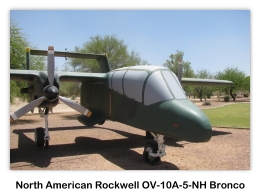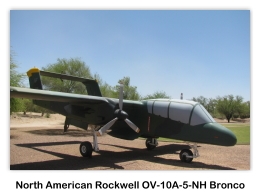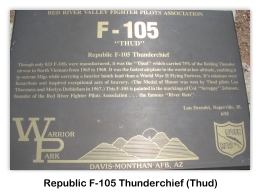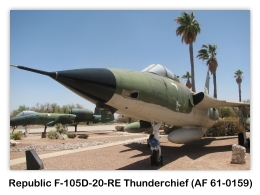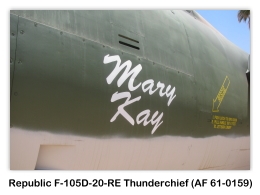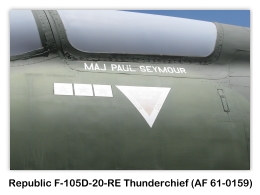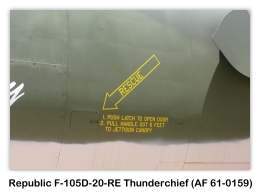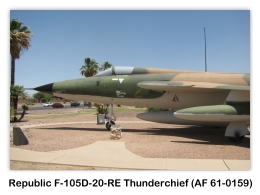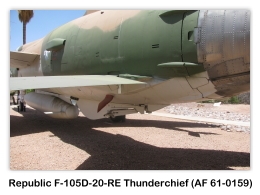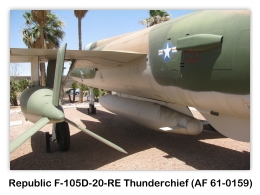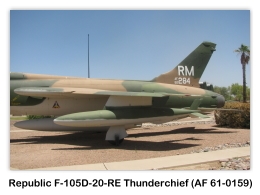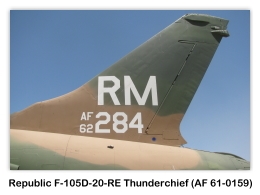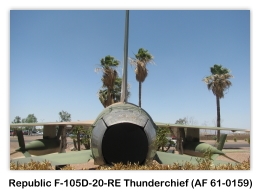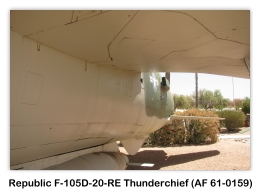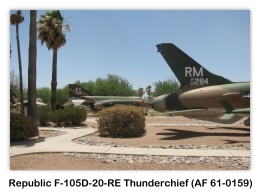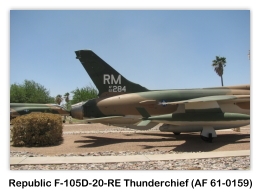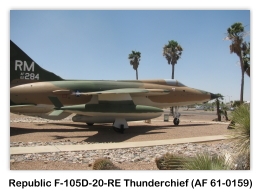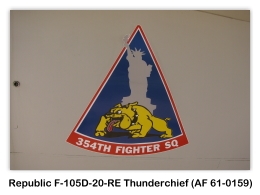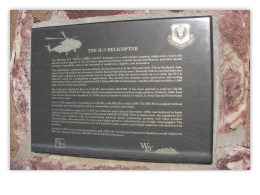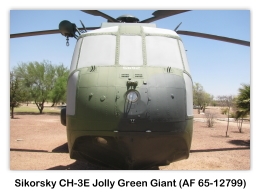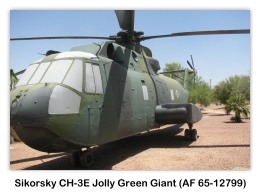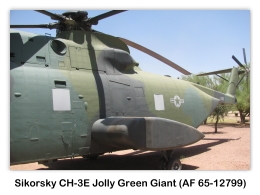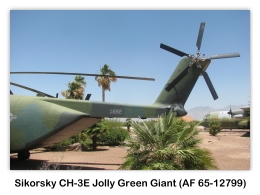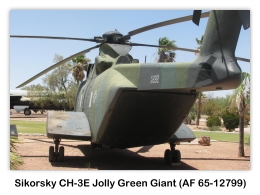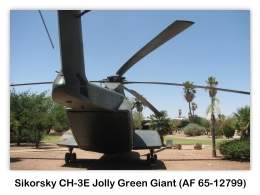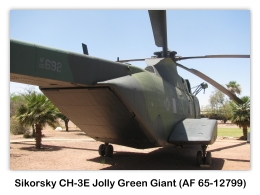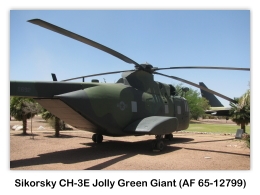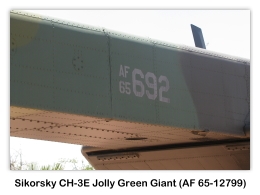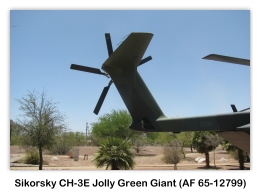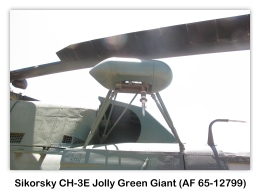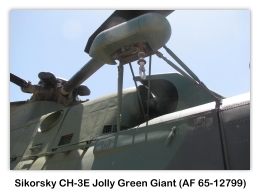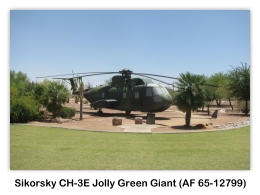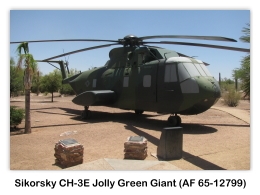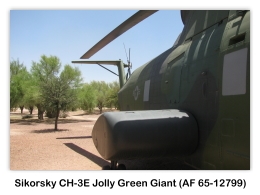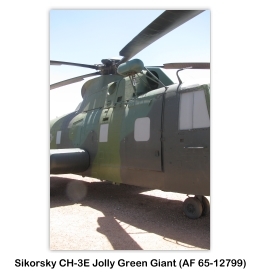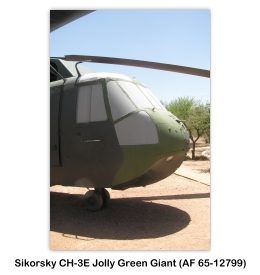

| Kurth Memorial Air Park, Tucson | Arizona Guide | Pima Air & Space Museum, Tucson |
Tucson — Warrior Park, Davis Monthan AFB
Arizona Aviation Museum Guide
Davis-Monthan AFB Heritage Park (Warrior Park) ¹
Recently AFIA (A Friend in Arizona) visited Davis-Monthan Air Force Base 4, located in Tucson Arizona. AFIA visited two locations on the base that highlighted the history of Davis-Monthan AFB with static displays of aircraft that were deployed on the base.
The first location was D-M's Heritage Park, also known as “Warrior Park.” Warrior Park is located inside the base at the intersection of Arizola Street and Craycroft Road. The park was built in the 1980's to provide the base with some recreational areas, as well as increasing its aesthetic appeal. Scattered throughout Heritage Park are static displays of various aircraft, as well as a history of each, D-M and the Air Force have used through the years to establish its air superiority. AFIA visited Warrior Park on 5/29/2011 and sent us a comprehensive “walk-around&rdqup; photo album of the park.
In a subsequent visit to D-M on 8/3/2011 AFIA visited the second location, which displays a lone North American F-86D/L-30-NA Sabre mounted on a pylon. The North American F-86 Sabre display is located inside the base at the intersection of South Phoenix Street and Douglas Street
During AFIA's two visits to D-M, the following aircraft displays were present:
- Boeing B-52D-30-BW Stratofortress (AF 56-0659, c/n 464030)
- Cessna O-1G Bird Dog (AF 51-12670)
- Fairchild Republic A-10A Thunderbolt II (AF 79-116, c/n 380)
- Ling-Temco-Vought A-7D-2-CV Corsair II (AF 68-8229, c/n D.015, painted as AF 71-0358)
- Lockheed C-130A-7-LM Hercules (AF 56-0493, c/n 182-3101)
- Lockheed U-2C Dragon Lady (AF 56-6716, c/n 383)
- McDonnell Douglas F-4B-14-MC Phantom II (BuNo 150639, c/n 297. Painted as F-4D-27-MC, AF 65-0639, c/n 1622. Originally F4H-1, then F-4G, then F-4B, then F-4N)
- North American F-86D/L-30-NA Sabre (AF 51-6071, c/n 173-219)
- North American F-100F-1-NA Super Sabre (AF 56-3727, c/n 3)
- North American Rockwell OV-10A-5-NH Bronco (AF 66-13560, c/n 305-9)
- Republic F-105D-20-RE Thunderchief (AF 61-0159, c/n D354, displayed as AF 62-4284)
- Sikorsky CH-3E Jolly Green Giant (AF 65-12799, c/n 61574 painted as AF 65-5692)
The following photographs are straight out of AFIA's camera.
Warrior Park ¹
Overview of Warrior Park (5/29/2011) at Davis-Monthan AFB, Tucson, Arizona (Photo by A Friend In Arizona, aka AFIA)
POW/MIA's Memorial Garden on display (5/29/2011) in the Warrior Park at Davis-Monthan AFB, Tucson, Arizona (Photo by A Friend In Arizona, aka AFIA)
Aircrew Memorials on display (5/29/2011) in the Warrior Park at Davis-Monthan AFB, Tucson, Arizona (Photo by A Friend In Arizona, aka AFIA)
Group/Wing/Operations Memorials on display (5/29/2011) in the Warrior Park at Davis-Monthan AFB, Tucson, Arizona (Photo by A Friend In Arizona, aka AFIA)
Boeing B-52D-30-BW Stratofortress ¹
Boeing B-52D-30-BW Stratofortress (AF 56-0659, c/n 464030) on display (5/29/2011) in the Warrior Park at Davis-Monthan AFB, Tucson, Arizona (Photo by A Friend In Arizona, aka AFIA)
Cessna O-1G Bird Dog ¹
Cessna O-1G Bird Dog (AF 51-12670) on display (5/29/2011) in the Warrior Park at Davis-Monthan AFB, Tucson, Arizona (Photo by A Friend In Arizona, aka AFIA)
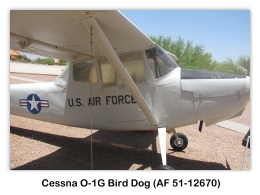

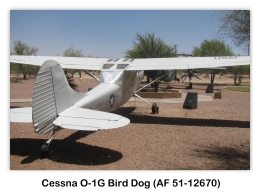

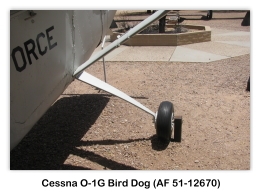
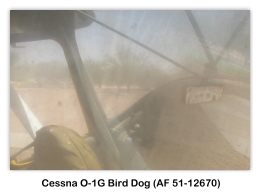
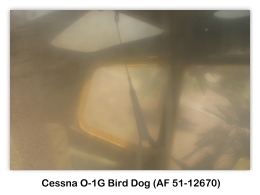
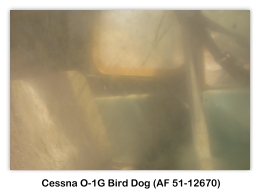
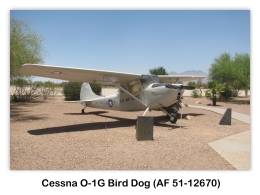
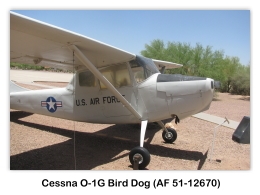
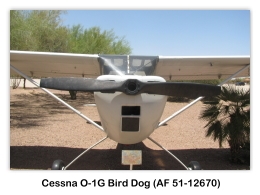
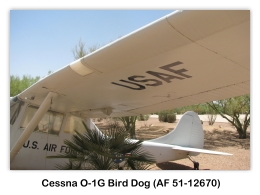
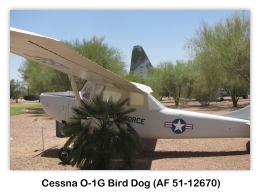
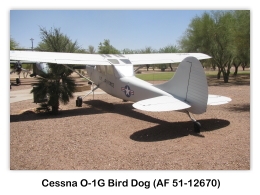
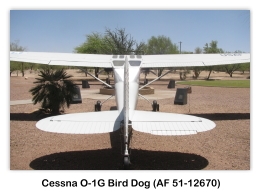
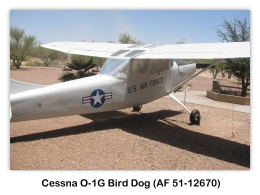
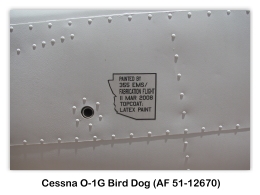
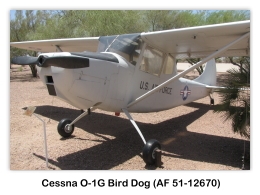
Fairchild Republic A-10A Thunderbolt II ¹
Fairchild Republic A-10A Thunderbolt II (AF 79-116, c/n 380) on display (5/29/2011) in the Warrior Park at Davis-Monthan AFB, Tucson, Arizona (Photo by A Friend In Arizona, aka AFIA)
Ling-Temco-Vought A-7D-11-CV Corsair II ¹
Ling-Temco-Vought A-7D-2-CV Corsair II (AF 68-8229, c/n D.015, painted as AF 71-0358) on display (5/29/2011) in the Warrior Park at Davis-Monthan AFB, Tucson, Arizona (Photo by A Friend In Arizona, aka AFIA)
Lockheed C-130A-11-CV Hercules ¹
Lockheed C-130A-7-LM Hercules (AF 56-0493, c/n 182-3101) on display (5/29/2011) in the Warrior Park at Davis-Monthan AFB, Tucson, Arizona (Photo by A Friend In Arizona, aka AFIA)
Lockheed U-2C Dragon Lady ¹
Lockheed U-2C Dragon Lady (AF 56-6716, c/n 383) on display (5/29/2011) in the Warrior Park at Davis-Monthan AFB, Tucson, Arizona (Photo by A Friend In Arizona, aka AFIA)
McDonnell Douglas F-4B-14-MC Phantom II ¹
McDonnell Douglas F-4B-14-MC Phantom II (BuNo 150639, c/n 297. Painted as F-4D-27-MC, AF 65-0639, c/n 1622. Originally F4H-1, then F-4G, then F-4B, then F-4N) on display (5/29/2011) in the Warrior Park at Davis-Monthan AFB, Tucson, Arizona (Photo by A Friend In Arizona, aka AFIA)
North American F-86D/L-30-NA Sabre ¹
North American F-86D/L-30-NA Sabre (AF 51-6071, c/n 173-219) on display (8/3/2011) at Davis-Monthan AFB, Tucson, Arizona (Photo by A Friend In Arizona, aka AFIA)
North American F-100F-1-NA Super Sabre ¹
North American F-100F-1-NA Super Sabre (AF 56-3727, c/n 3) on display (5/29/2011) in the Warrior Park at Davis-Monthan AFB, Tucson, Arizona (Photo by A Friend In Arizona, aka AFIA)
North American Rockwell OV-10A-5-NH Bronco ¹
North American Rockwell OV-10A-5-NH Bronco (AF 66-13560, c/n 305-9) on display (5/29/2011) in the Warrior Park at Davis-Monthan AFB, Tucson, Arizona (Photo by A Friend In Arizona, aka AFIA)
Republic F-105D-20-RE Thunderchief ¹
Republic F-105D-20-RE Thunderchief (AF 61-0159, c/n D354, displayed as AF 62-4284) on display (5/29/2011) in the Warrior Park at Davis-Monthan AFB, Tucson, Arizona (Photo by A Friend In Arizona, aka AFIA)
Sikorsky CH-3E Jolly Green Giant ¹
Sikorsky CH-3E Jolly Green Giant (AF 65-12799, c/n 61574 painted as AF 65-5692) on display (5/29/2011) in the Warrior Park at Davis-Monthan AFB, Tucson, Arizona (Photo by A Friend In Arizona, aka AFIA)
Davis-Monthan AFB ²
- Davis-Monthan Air Force Base
- Part of Air Combat Command (ACC)
- Located near: Tucson, AZ
- Built: 1925
- In use: 1941 - present
- Controlled by: United States Air Force
- Garrison: 355th Wing
- Airfield information: IATA: DMA - ICAO: KDMA - FAA LID: DMA
- Elevation AMSL: 2,704 ft (824 m)
Davis-Monthan Air Force Base (DM AFB) (IATA: DMA, ICAO: KDMA, FAA LID: DMA) is a United States Air Force base located within the city limits, and approximately 5 miles (8.0 km) south-southeast of downtown, Tucson, Arizona.
The host unit at Davis-Monthan is the 355th Fighter Wing (355 FW) assigned to Twelfth Air Force, which is headquartered at DM and is part of Air Combat Command (ACC). The 355 FW and various tenant units located on base provide Republic A-10 Thunderbolt II close air support; Republic OA-10 Thunderbolt II forward air controllers; air liaison officers; EC-130 command, control and communications warfare; air control radar; combat search and rescue; and combat support forces to unified commanders. The 355 FW also provides initial and recurrency flying training to all U.S. Air Force Republic A/OA-10 Thunderbolt IIs and Lockheed EC-130 Hercules pilots and crews; and is the ACC's executive agent for INF and START treaty compliance. Although under ACC, it is best known for its role as the location of the Air Force Materiel Command's 309th Aerospace Maintenance and Regeneration Group (AMARG), better known as the sole aircraft boneyard for all excess military and government aircraft, as its location allows for preservation of the aircraft.
Davis-Monthan AFB was established in 1925 as Davis-Monthan Landing Field, and is named in honor of World War I pilots Lieutenants Samuel H. Davis and Oscar Monthan, both Tucson natives.
In 2012, the installation was honored as the best Air Force base in the world when it collectively earned the Commander-In Chief (CINC) Installation Excellence Award, beating out 161 USAF installations eligible for honors. The commander of the 355th FW is Colonel Kevin Blanchard; the Command Chief Master Sergeant is CMSgt Dawna Cnota.
Overview ²
Davis-Monthan Air Force Base is a key ACC installation. The 355 FW is the host unit providing medical, logistical, mission support, and operational support to all assigned units. The wing's missions are to train Republic A-10 and OA-10 Thunderbolt II pilots and to provide Republic A-10 and OA-10 Thunderbolt II close support and forward air control to ground forces worldwide. One of the wing's tenant units, the 55th Electronic Combat Group, is tasked to provide command, control, and communications countermeasures in support of tactical forces with its Lockheed EC-130H Compass Call aircraft and, employing the Lockheed EC-130E ABCCC aircraft, provide airborne command, control, and communications capabilities for managing tactical air operations in war and other contingencies worldwide. Two other major tenants, the 563rd Rescue Group (structured under the 23d Wing, Moody Air Force Base) and 943rd Rescue Group, (structured under the 920th Rescue Wing, Patrick Air Force Base), are tasked to provide combat search and rescue support worldwide.
Although under ACC, it is best known for its role as the location of the Air Force Materiel Command's 309th Aerospace Maintenance and Regeneration Group (AMARG), better known as the sole aircraft boneyard for all excess military and government aircraft. Davis-Monthan was selected due to its low humidity and hard, alkaline soil, which allows the aircraft to be naturally preserved for cannibalization or possible reuse.
Wing Units ²
The host wing at Davis-Monthan is the 355th Fighter Wing, which includes:
355th Operations Group: Consists of six squadrons and over 450 personnel employing 82 Republic A-10 Thunderbolt II aircraft and an AN/TPS-75 radar system. It provides war-fighters with forces for close air support (CAS), air interdiction (AI), forward air control (FAC), combat search and rescue (CSAR), ground based tactical air control, and airbase operations. It also conducts all formal course directed aircraft initial qualification/ re-qualification training. All active duty aircraft assigned to Davis-Monthan Air Force Base carry the tail code "DM".
354th Fighter Squadron: (Republic A-10C Thunderbolt II) Bulldogs Blue Fin Flash
357th Fighter Squadron: (Republic A-10C Thunderbolt II) Dragons Yellow Fin Flash
358th Fighter Squadron: (Republic A-10A Thunderbolt II) Lobos Black Fin Flash
355th Operations Support Squadron
355th Training Squadron
607th Air Control Squadron
West Coast Republic A-10 Thunderbolt II Demonstration Team: Consists of 12 members and is assigned to the 355th Operations Group. The team's primary mission is to encourage retention and recruitment by showcasing the Air Force's premier fighter/attack aircraft, the rugged and dependable Republic A-10 Thunderbolt II. Performing at more than 30 air shows annually before 15 million spectators worldwide, the Republic A-10 Thunderbolt II Demo Team provides insight about Air Combat Command and the United States Air Force.
355th Mission Support Group: Consists of about 2,000 military and civilian personnel in six diverse squadrons that train, equip and provide agile combat mission support, including civil engineering, communications, contracting, transportation, fuels, supply, deployment readiness, personnel, security forces, and services for immediate worldwide deployment of combat support elements. The group also provides an effective in-garrison support infrastructure and quality of life services for 26 wing and 32 associate units spanning a 60,000-person, 10,763 acres (43.56 km²) community, one of the largest in Air Combat Command.
355th Maintenance Group: Supports eight flying squadrons comprising 82 Republic A-10 Thunderbolt II, 14 Lockheed EC-130 Hercules, 8 Sikorsky HH-60 Pave Hawk, and 6 Lockheed HC-130 Hercules combat-ready aircraft with over 1,700 assigned personnel. It ensures quality of on- and off-equipment aircraft maintenance and executes an annual O&M budget of $1.5M.
355th Medical Group: Ensures that personnel are medically ready to fight; train and to equip fully deployable medical teams; and meet the health care needs of our patients. Their goal is to maintain combat medical readiness of the 355 FW for global contingencies with an authorized staff of 395, a resource allocation exceeding $37 million, and 21 mobility teams, including Expeditionary Medical Support teams. The 355 MDG strives to provide timely and comprehensive medical services, promote both health and wellness of more than 50,000 Department of Defense beneficiaries, and build a resilient community at Davis-Monthan AFB.
Tenant Units ²
Headquarters, Twelfth Air Force
612th Air Operations Group
612th Air Communications Squadron
612th Air Intelligence Squadron
612th Air and Space Operations Center - operates AFSOUTH's Combined Air and Space Operations Center (CAOC)
563d Rescue Group
48th Rescue Squadron (Pararescue)
55th Rescue Squadron (Sikorsky HH-60G Pave Hawk)
79th Rescue Squadron (Lockheed HC-130P Combat King)
563rd Operations Support Squadron
55th Electronic Combat Group
41st Electronic Combat Squadron (Lockheed EC-130H Compass Call) Scorpions Blue Tail Stripe
42d Electronic Combat Squadron (Lockheed EC-130H Compass Call) Raptors Yellow Tail Stripe
43d Electronic Combat Squadron (Lockheed EC-130H Compass Call) Bats Red Tail Stripe
309th Aerospace Maintenance and Regeneration Group (AMARG), (Air Force Materiel Command): This group is responsible for the base's aircraft "graveyard", the largest in terms of number of planes in the world, where old military and other aircraft are stationed either to be stored, pulped, stripped or restored for service.
943rd Rescue Group - Air Force Reserve Command unit assigned to Davis-Monthan that falls under the 920th Rescue Wing (920 RQW) at Patrick AFB, Florida.
305th Rescue Squadron (Sikorsky HH-60G Pave Hawk)
306th Rescue Squadron
943rd Operations Support Flight
214th Reconnaissance Group (214 RG): Arizona Air National Guard unit flying the General Atomics MQ-1 Predator.
The base provides additional active duty support to the 162d Fighter Wing (162 FW) of the Arizona Air National Guard, located at nearby Tucson International Airport, which flies the Lockheed Martin F-16C and F-16D Fighting Falcon.
Other military activities and federal agencies using the base include Navy Operational Support Center Tucson, a detachment of the Naval Air Systems Command, the Federal Aviation Administration, the U.S. Customs Service Air Service Branch, the U.S. Army Corps of Engineers, and the Federal Law Enforcement Training Center. Also located on base is the 25th Operational Weather Squadron 25 OWS. The squadron produces forecasts for the Western United States and is part of the 1st Weather Group (1 WXG) headquartered at Offutt Air Force Base, Nebraska. The squadron also serves as a training hub for new weather professionals - both enlisted and officers.
History ²
The base was named in honor of Lieutenants Samuel H. Davis and Oscar Monthan, two Tucsonans and World War I-era pilots who died in separate military aircraft accidents. Davis, who died in a Florida aircraft accident in 1921, attended the University of Arizona prior to enlisting in the Army in 1917. Monthan enlisted in the Army as a private in 1917, was commissioned as a ground officer in 1918, and later became a pilot. He was killed in a crash of a Martin bomber in Hawaii in 1924.
Origins ²
In 1919 the Tucson Chamber of Commerce aviation committee established the nation's first municipally owned airfield at the current site of the Tucson Rodeo Grounds. The rapid increase in aviation activities meant a move in 1927 to the site which is now Davis-Monthan Air Force Base. After the City of Tucson acquired land southeast of town for a runway in 1925, Charles Lindbergh, fresh from his nonstop crossing of the Atlantic Ocean, flew his Spirit of St. Louis to Tucson in 1927 to dedicate Davis-Monthan Field, then the largest municipal airport in the United States.
Standard Airlines, later absorbed by American Airlines, remained in business for about 30 months. Frye, as well as being the founder of the company, was also an active pilot of the line. Because of the Great Depression, Frye and his associates sold the airline to Western Air Express in March 1930. Concomitant with the sale, Frye joined Western Air Express on the Board of Directors and as Chief of Operations. Later in 1930, Western Air Express merged with Transcontinental Air Transport in 1930 to form T&WA (TWA). Frye became president of T&WA in 1934 and Richter became Vice President. TWA was known as "The Airline Run by Flyers."
Military presence at the field began when Sergeant Simpson relocated his fuel and service operation to the site on 6 October 1927. He kept a log containing names of the field's customers, including Lindbergh, Amelia Earhart, Benjamin Foulois, and Jimmy Doolittle. Doolittle, awarded the Medal of Honor for his 1942 Tokyo raid, was the first military customer at the field on 9 October 1927. The combination of civil and military operations worked well until the early 1940s when military requirements began to require the relocation of civil aviation activities.
World War II ²
Davis-Monthan Airport became Tucson Army Air Field in 1940 as the United States prepared for World War II. The first assigned U.S. Army Air Corps units were the 1st Bomb Wing, 41st Bomb Group, and 31st Air Base Group, activating on 30 April 1941. In its military role, the base became known as Davis-Monthan Army Air Field on 3 December 1941. Even before Pearl Harbor on 7 December 1941, Air Corps leaders started to increasingly utilize the airfield, sending Boeing B-29 Superfortresses and Consolidated B-24 Liberator heavy bombers and Douglas B-18 Bolo which were used both for training and observation missions.
Several known bombardment groups trained at DM during the war:
- 34th Bombardment (Heavy) 13 May 1942 - 4 July 1942
- 94th Bombardment (Heavy) August 1942 - 1 November 1942
- 302nd Bombardment (Heavy) 23 June 1942 - 30 July 1942
- 308th Bombardment (Heavy) 20 June 1942 - 1 October 1942
- 380th Bombardment (Heavy) 4 November 1942 - 2 December 1942
- 382nd Bombardment (Heavy) 23 January 1943 - 5 April 1943
- 389th Bombardment (Heavy) 24 December 1942 - 1 February 1943
- 392nd Bombardment (Heavy) 26 January 1943 - 1 March 1943
- 399th Bombardment (Heavy) 1 March 1943 - 10 April 1943
- 400th Bombardment (Heavy) April 1943 - 2 May 1943
- 446th Bombardment (Heavy) 1 April 1943 - 8 June 1943
- 449th Bombardment (Heavy) 1 May 1943 - 5 July 1943
- 451st Bombardment (Heavy) 1 May 1943 - 3 June 1943
- 459th Bombardment (Heavy) 20 September 1943 - 1 November 1943
- 466th Bombardment (Heavy) 15 August - 17 October 1945
- 486th Bombardment (Heavy) 9 November 1943 - March 1944
- 489th Bombardment (Heavy) 3 April 1945 - 13 July 1945
- 491st Bombardment (Heavy) 1 October 1943 - 11 November 1943
- 444th Bombardment (Very Heavy) 1 March 1943 - 29 July 1943
- 499th Bombardment (Very Heavy) 20 November 1943 - 1 December 1943
Training at the airfield came to a halt on 14 August 1945, when the Japanese unconditionally surrendered. Davis-Monthan played a post-war role by housing German POW's from June 1945 to March 1946.
Postwar Years ²
With the end of the war, operations at the base came to a virtual standstill. It was then the base was selected as a storage site for hundreds of decommissioned aircraft with the activation of the 4105th Army Air Force Unit. The 4105th oversaw the storage of excess Boeing B-29 Superfortresses and Douglas C-47 Gooney Birds. Tucson's dry climate and alkali soil made it an ideal location for aircraft storage and preservation, a mission that has continued to this day. The airfield also acted as a separation center, which brought the base populace to a high of 11,614 people in September 1945.
Cold War ²
The Cold War era was ushered in at Davis-Monthan in March 1946, in the form of the 40th and 444th Bombardment Groups, both equipped with Boeing B-29 Superfortresses. As part of the postwar austerity, these groups were inactivated, with the personnel and equipment being consolidated into the 43d Bombardment Group in October. On 11 January 1948, with the establishment of the United States Air Force, the facility was renamed Davis-Monthan Air Force Base. On 30 June 1948, the Air Force activated the 43rd Air Refueling Squadron, whose Boeing KB-29M Tankers were newly equipped with aerial refueling equipment purchased from the British firm FRL. The 43rd ARS, along with the 509th ARS at Walker AFB, New Mexico, was the first dedicated air refueling unit in history.
On 2 March 1949, the Lucky Lady II, a Boeing B-50A Superfortress of the 43d Bombardment Wing, completed the first nonstop round-the-world flight, having covered 23,452 miles (37,742 km) in 94 hours and 1 minute (249.45 mph). Lucky Lady II was refueled four times in the air by Boeing KB-29 Superfortress tankers of the 43d Air Refueling Squadron, which had made only one operational air refueling contact before the mission. For this outstanding flight, the Lucky Lady II's crew received the Mackay Trophy, given annually by the National Aeronautic Association for the outstanding flight of the year, and the Air Age Trophy, an Air Force Association award, given each year in recognition of significant contributions to the public understanding of the air age.
In 1953, the jet age came to Davis-Monthan when SAC units on the base converted to the new Boeing B-47 Stratojet. The 303d Bombardment Wing, Medium, was initially established on 27 August 1951, and activated at Davis-Monthan AFB on 4 September 1951. The wing operated Boeing B-29 Superfortresses until January 1952, when it was equipped with Boeing KB-29 Superfortress tankers. On 20 January 1953, the 303d transitioned to the Boeing B-47 Stratojet for its three bomb squadrons, while an additional air refueling squadron equipped with Boeing KC-97 Stratotankers was assigned to the wing between 18 February 1953, and 1 February 1956. A standard SAC Alert Area ramp was constructed in the southeast corner of the base adjacent to the runway and the 303d assumed nuclear alert responsibilities was final conversion and checkout in the Boeing B-47 Stratojet was complete.
In April 1953 the Air Defense Command's (ADC) 15th Fighter-Interceptor Squadron was activated with North American F-86A Sabres. A year later, the unit transitioned into North American F-86D Saber Dogs followed by a transition to North American F-86L Sabres in the fall of 1957. In the spring of 1959 the unit received Northrop F-89J Scorpion interceptors which it flew for only a year when it transitioned into McDonnell F-101B Voodoos. On 24 December 1964, the 15th FIS was deactivated.
In 1962, the Strategic Air Command's 390th Strategic Missile Wing (390 SMW) and its 18 Martin Titan II ICBM sites around Tucson were activated. The 390 SMW was one of only three Martin Titan II missile wings in SAC and represented the heaviest land-based missile and the largest single warhead ever fielded by U.S. strategic deterrent forces.
In July 1963, the 4028th Strategic Reconnaissance Weather Wing, equipped with Lockheed U-2 strategic reconnaissance aircraft, began flying global missions from Davis-Monthan. Following the Cuban Missile Crisis in 1963, the 4080th Strategic Reconnaissance Wing at Laughlin AFB, Texas, relocated to the base and assumed responsibility for all Lockheed U-2 operations, emphasizing long-range strategic reconnaissance and intelligence collection. As a Strategic Air Command (SAC) unit, the 4080th was later redesignated the 100th Strategic Reconnaissance Wing and also acquired Lockheed DC-130 Hercules aircraft for launch and control of Ryan Firebee reconnaissance drones that were the precursors of contemporary unmanned aerial systems. The Lockheed DC-130 Hercules and Lockheed U-2 Dragon Ladys remained at the Davis-Monthan until 1976, when the 100 SRW was inactivated, its Lockheed DC-130 Hercules transferred to Tactical Air Command's 432d Tactical Drone Group, and its Lockheed U-2 Dragon Ladys transferred to SAC's 9th Strategic Reconnaissance Wing (9 SRW) at Beale Air Force Base, California, where Lockheed U-2 Dragon Lady operations were consolidated with the Lockheed SR-71 Blackbird operations.
On 15 June 1964, Davis-Monthan's 303d Bombardment Wing was inactivated as part of the retirement of the Boeing B-47 Stratojet from active service. The year 1964 brought back the combat crew training mission of the World War II years with the 4453d Combat Crew Training Wing equipped with the Air Force's newest and most sophisticated fighter, the McDonnell Douglas F-4 Phantom II. In July 1971, the 355th Tactical Fighter Wing, flying the Ling-Temco-Vought A-7 Corsair II aircraft, was activated at the base and the previously assigned McDonnell Douglas F-4 Phantom II fighters were moved to Luke AFB, near Phoenix, Arizona.On 1 October 1976, the base was transferred to Tactical Air Command (TAC) after 30 years under SAC. It was also that year the 355th Tactical Fighter Wing accepted the first Fairchild-Republic A-10 Thunderbolt II. Since 1979, D-M has been the training location for pilots in the Republic A-10 Thunderbolt II; the base was redesignated the 355th Tactical Training Wing on 1 September 1979. The organization was later redesignated the 355th Fighter Wing since it includes operational, deployable Republic A-10 Thunderbolt II squadrons in addition to its CONUS training mission.
The 1980s brought several diverse missions to D-M. The headquarters charged with overseeing them was now the 836th Air Division, which was activated 1 January 1981. The AD advised Air Force component commanders and land forces on Republic A-10 Thunderbolt II aircraft tactics, training, employment and readiness, and subordinate units participated in exercises such as Red Flag and Celtic Echo.
The 41st Electronic Combat Squadron, equipped with Lockheed EC-130H Compass Call aircraft, arrived on 1 July 1980, and reported to the 552d Airborne Warning and Control Wing. In 1981 D-M welcomed the 868th Tactical Missile Training Group. The 868th was the only U.S.-based Ground Launched Cruise Missile (GLCM) unit and the source of the crews that staffed the forward deployed GLCM wings in NATO in 1982.
On 1 September 1982, the headquarters of the 602nd Tactical Air Control Wing (TAIRCW) and its subordinate 23rd Tactical Air Support Squadron (TASS), a unit responsible for the Air Force's tactical air control system west of the Mississippi River transferred from Bergstrom Air Force Base, Texas, and stood up at D-M, bringing 16 Cessna OA-37B Dragonfly aircraft and numerous new personnel to the base. The 23rd TASS became the Air Force's first Republic O/A-10 Thunderbolt II squadron in 1988, providing heavily armed airborne forward air control (FAC) capability for the first time. Unlike all other D-M aircraft at the time, the 23rd TASS fleet's tail flash read "NF", for "Nail FAC"; the squadron's radio call sign was "Nail."
In 1984, as a result of the first series of Strategic Arms Reduction Treaties START I between the United States and the Soviet Union, SAC began to decommission its Martin Titan II missile system. In 1982, the 390 SMW began removing its 18 missiles and inactivating the associated sites in preparation for eventual demolition.
In October 1981, President Ronald Reagan announced that, as part of the strategic modernization program, Martin Titan II systems were to be retired by 1 October 1987. Deactivation began at Davis-Monthan on 1 October 1982. During the operation, titled Rivet Cap, the missiles were removed and shipped to Norton AFB, California for refurbishment and storage. Explosive demolition began at the headworks of missile complex 570-7 on 30 November 1983. In May 1984, the 390 SMW's last Martin Titan II at Davis-Monthan came off alert status. SAC subsequently deactivated the 390th Strategic Missile Wing on 30 June 1984.
One site under the 390 SMW, known both as Martin Titan II Site 571-7 and as Air Force Facility Missile Site 8, was initially decommissioned in 1982. Located approximately 12 miles (19 km) south of Tucson in Sahuarita, Arizona, it was saved from demolition and turned over to the Arizona Aerospace Foundation, a nonprofit organization which also administers the Pima Air and Space Museum immediately south of Davis-Monthan. With a variety of items on loan from the National Museum of the United States Air Force, including an inert Martin Titan II missile, Site 571-7 is now known as the Titan Missile Museum and is the sole remaining example of a Martin Titan II missile site in existence. In 1994, the site was declared a National Historic Landmark.
Modern Era ²
In the 1990s, the 355 TTW continued to train Republic A-10 Thunderbolt II crews for assignments to units in the United States, England, and Korea. During this period, the 602nd Tactical Air Control Wing deployed Airborne Forward Air Controllers in their Republic OA-10 Thunderbolt II aircraft to Operation Desert Storm, providing nearly 100 percent of this capability to the war.
On 1 October 1991, the 355 TTW was redesignated as the 355th Fighter Wing (355 FW) in tune with the Air Force's Objective Wing philosophy. The 355th Fighter Wing was composed of the 355th Operations Group (355 OG), the 355th Maintenance Group (355 MG), the 355th Medical Group (355 MDG), and the 355th Mission Support Group (355 MSG).
In May 1992, the 41st and 43d Electronic Combat Squadron, flying Lockheed EC-130E Hercules Compass Call arrived. The aircraft carried an airborne battlefield command and control center capsule that provides continuous control of tactical air operations in the forward battle area and behind enemy lines. This capability added yet more strength to the wing's combat capability. The 43rd Electronic Combat Squadron Bats are part of the 55th Wing (55 WG) at Offut AFB, Nebraska, but operate out of Davis-Monthan. In addition, the 42d Airborne Command and Control Squadron arrived from Keesler AFB, Mississippi on 19 July 1994.
On 1 May 1992, senior Air Force leaders implemented the policy of one base, one wing, one boss. The 836 AD and 602 TAIRCW inactivated while the 41 ECS and 43 ECS came under control of the 355 FW. With the mission diversified, the 355th Fighter Wing was redesignated as the 355th Wing (355 WG). Following Operation Desert Storm, the 355 WG supported Operation Southern Watch during deployments to Al Jaber, Kuwait, in 1997 by deploying 24 Republic A-10 Thunderbolt IIs, in 1998 by deploying 16 Republic A-10 Thunderbolt IIs, and in 1999 by deploying 14 Republic A-10 Thunderbolt IIs — all to ensure compliance of the 33rd parallel southern no-fly zone. The flight and mysterious crash of Captain Craig D. Button took off from Davis-Monthan Air Force Base on 12 April 1997.
Global War on Terrorism ²
The attacks on 11 September 2001, led to the initiation of three ongoing missions: Operation Enduring Freedom (OEF), Operation Iraqi Freedom (OIF), and Operation Noble Eagle (ONE).
After the execution of Operation Enduring Freedom, eight Republic A-10 Thunderbolt IIs from the 355 WG were called to Bagram Air Base, Afghanistan, to fly close air support missions supporting multinational ground forces.
In September 2002, the 48th, 55th, and the 79th Rescue Squadron's (RQS) transferred under control of the 355 WG, equipped with Lockheed HC-130 Combat King aircraft and Sikorsky HH-60 Pave Hawk helicopters. At the same time, the 41st and 43d Electronic Combat Squadrons were realigned under the control of the 55th Electronic Combat Group (55 ECG). While personnel and aircraft remained on Davis-Monthan AFB, operational control of the 55 ECG was assumed by the 55th Wing at Offutt AFB, Nebraska. Another major wing realignment occurred on 1 October 2003, with the activation of the 563rd Rescue Group (563 RQG) on Davis-Monthan AFB. Control of the 48th, 55th, and 79th Rescue Squadrons (RQS) was passed to the new group with the 23rd Wing (23 WG) at Moody Air Force Base, Georgia assuming operational command of the unit.
In 2003 and 2005, the 354th Fighter Squadron (354 FS) Bulldogs deployed on five-month deployments to Bagram Air Base in Afghanistan. During these deployments, they provided 24-hour presence to reassure the Afghan population as it struggled with its emergent democracy, and provided key support during national elections. While the 2003 deployment saw limited action, the Bulldogs employed over 22,000 rounds of 30 mm during 130 troops-in-contact situations during the 2005 deployment. Returning to Afghanistan in April 2007 for another six-month deployment, the 345th again provided 24-hour presence and Close Air Support expertise to coalition forces in support of Operation Enduring Freedom. During this period, insurgent activity level was the highest recorded to date in OEF. The Bulldogs employed an unprecedented number of munitions during this deployment—over 150,000 rounds of 30 mm in support of over 400 troops-in-contact situations.
Another major change occurred on 26 April 2007. With only Republic A-10 Thunderbolt II fighter aircraft assigned, the 355th Wing was redesignated once again as the 355th Fighter Wing (355 FW). Also in 2007, the 214th Reconnaissance Group (214 RG), an Arizona Air National Guard unit, was activated. Today, the 355 FW is composed of four groups: the 355th Operations Group (355 OG), the 355th Maintenance Group (355 MG), the 355th Mission Support Group (355 MSG), and the 355th Medical Group (355 MDG). Together, along with their tenant organizations, they make up the 6,000 Airmen and 1,700 civilian personnel at Davis-Monthan AFB.
On Friday, 16 September 2011, the Base was placed on lockdown; news agencies reported shots may have been fired, possibly with injuries (the military spokesperson later said this was not the case, the base was simply on alert because an armed individual walked on to and was holed up in a building on the base). An ambulance had been called, but that was coincidental - a case of bad timing - as it was meant for a woman that had gone into labor. The military spokesperson, Technical Sergeant Russ Martin, stated that in fact there were no injuries or shots fired. No one is allowed on or off the Base; all students were accounted for. Because of the lockdown, there was a single point of entry at the Base. Later, the lockdown was ended; the situation apparently was peacefully resolved.
Previous Names ²
- Established as: Davis-Monthan Landing Field, 1 November 1925
- Tucson Municipal Airport, 6 October 1927
- Davis-Monthan Field, 3 December 1941
- Davis-Monthan AFB, 13 January 1948-present
Major Commands to Which Assigned ²
- Fourth Air Force, 1 February 1942 - 8 February 1943
- Second Air Force, 8 February 1943 - 16 November 1945
- Air Technical Service Command, 16 November 1945 - 31 March 1946
- Strategic Air Command, 31 March 1946 - 1 October 1976
- Tactical Air Command, 1 October 1976 - 1 June 1992
- Air Combat Command, 1 June 1992 - present
Major Units Assigned ²
- 1st Bombardment Wing, 28 May 1941 - 16 July 1942
- 2nd Bombardment Wing, 31 December 1948 - 1 January 1949
- 4th (later IV) Bomber Command, 19 September - 15 December 1941
- 5th Altitude Training Unit, 10 April 1943 - 1 April 1944
- 12th Air Division, 16 January 1962 - 30 September 1976
- Twelfth Air Force, 1 October 1992 - present
- 15th Fighter-Interceptor Squadron (ADC), 20 April 1953 - 24 December 1964
- 16th Bombardment Operational Training Wing, 1 June - 12 October 1943
- 28th Services Group, 10 May 1946 - 19 November 1947
- 31st Air Base Group, 30 April 1941 - 30 April 1942
- Redesignated: 31st Service Group, 30 April - 16 August 1942
- 32d Base HQ and Air Base Sq, 13 June 1942 - 25 March 1944
- 34th Bombardment Group, 13 May - 1 July 1942
- 36th Air Division, 15 June 1952 - 15 March 1960
- 39th Bombardment Group, 5 February - 1 April 1942
- 39th Bombardment Group, 1 September - 17 October 1945
- 40th Bombardment Group, 13 May - 1 October 1946
- 41st Bombardment Group, 15 January - 14 May 1941
- 43d Bombardment Group, 1 October 1946 - 17 November 1947
- 43d Bombardment Wing, 17 November 1947 - 15 March 1960
- 55th Electronic Combat Group, 1 April 1992 - present
- 57th Fighter Squadron, 15 May 1947 - 27 June 1949
- 100th Strategic Reconnaissance Wing, 25 June 1966 - 30 September 1976
- 233d AAF Base Unit, 25 March 1944 - 16 November 1945
- 248th AAF Base Unit, 31 March 1946 - 19 November 1947
- 302d Bombardment Group, 23 June - 30 July 1942; 2 December 1942 - 27 January 1943
- 303d Air Services Group, 27 September - 7 November 1947
- 303d Bombardment Wing, 4 September 1951 - 8 June 1964
- 308th Bombardment Group, 20 June - 1 October 1942
- 327th Air Base Group, 2 March - 1 May 1942
- 335th Air Base Group, 30 March 1942 - 2 February 1943
- 355th Fighter Wing (Various Designations) 1 July 1971 - present
- 380th Bombardment Group, 3 October - 1 December 1942
- 381st Base HQ & Air Base Group, 27 June - 18 November 1942
- 382d Bombardment Group, 23 January 1942 - 4 April 1943
- 385th Bombardment Group, 1 December 1942 - 3 January 1943
- 389th Bombardment Group, 24 December 1942 - 1 February 1943
- 390th Bombardment (later Strategic Missile) Wing, 1 January 1962 - 1984
- 392d Bombardment Group, 26 January - 1 March 1943
- 399th Bombardment Group, 1 March - 10 April 1943
- 400th Bombardment Group, 11 April - 1 May 1943
- 419th Army Air Force (later Air Force) Base Unit, 1 November 1946 - 27 June 1949
- 432d Tactical Drone Group, 1 July 1976 - 1 April 1979
- 444th Bombardment Group, 1 March - 31 July 1943; 1 May - 1 October 1946
- 446th Bombardment Group, 1 April - 6 June 1943
- 447th Bombardment Group, 1 May - 4 July 1943
- 449th Bombardment Group, 1 May - 5 July 1943
- 451st Bombardment Group, 1 May - 3 June 1943
- 459th Bombardment Group, 22 September - 25 October 1943
- 459th Bombardment Group, 27 January 1949 - 16 June 1951
- 466th Bombardment Group, 26 August - 17 October 1945
- 491st Bombardment Group,1 October - 11 November 1943
- 486th Bombardment Group, 9 November 1943 - 9 March 1944
- 489th Bombardment Group, 3 April - 13 July 1945
- 499th Bombardment Group, 20 November - 1 December 1943
- 502d Bombardment Group, 1-5 June 1944
- 563d Rescue Group, 1 October 2003 - present
- 803d Air Base (later Combat Support) Group, 16 June 1952 - 30 April 1976
- 836th Air Division, 1 January 1981 - 1 May 1992
- 943d Rescue Group, 12 April 2005 - present
- 2704th AAF Aircraft Storage & Disposition Group, 1 August 1959 - 1 February 1965
- Redesignated: Military Aircraft Storage and Redistribution Center, 1 February 1965 - 1 July 1984
- Redesignated: Aerospace Maintenance and Regeneration Center, 1 July 1984
- Redesignated: 309th Aerospace Maintenance and Regeneration Group, 1 May 2007 - present
- 4080th Strategic Wing, 1 July 1963 - 25 June 1966
- 4105th AAF Base Unit, 16 November 1945 - 31 March 1946
- 4453d Combat Crew Training Wing, 1 July 1964 - 30 September 1971
Special Thanks
A very special thanks to AFIA (A Friend in Arizona) for providing us with photos of the aircraft at this location.
References
- Photos: AFIA (A Friend in Arizona)
- Wikipedia, Davis-Monthan Air Force Base
- Google Earth: Satellite Images
- Davis-Monthan AFB
Copyright © 2014 Skytamer Images, Whittier, California
All rights reserved
